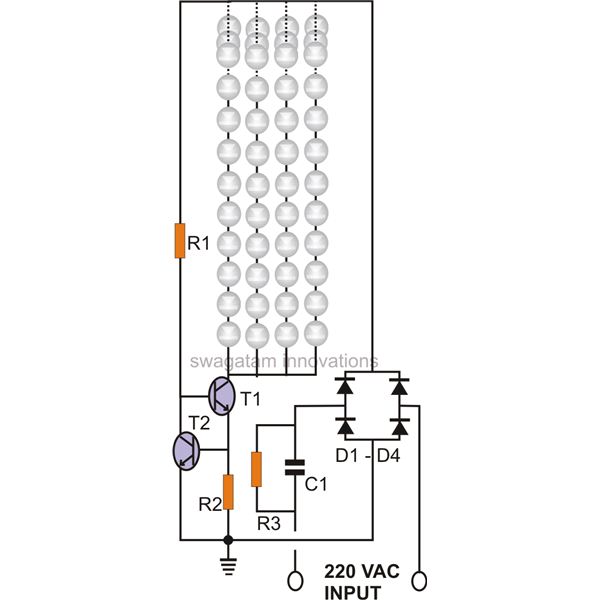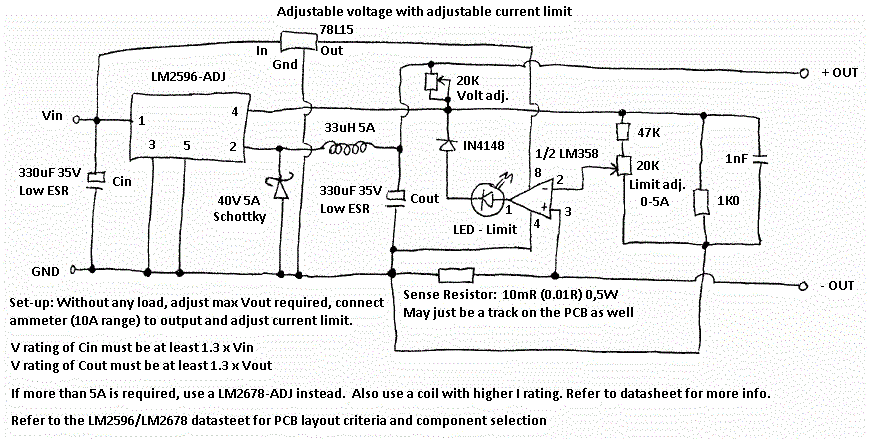
simple current controlled led tube

The circuit of a current-controlled LED tube light employs high-voltage transistors to implement the necessary current control operation based on a fundamental principle. A resistor (R2) is utilized to convert the increasing current into a voltage across itself. This voltage is detected by R2, which subsequently conducts and grounds the base of transistor T1, rendering it inactive. This instantaneous process initiates a switching effect, resulting in the desired current control and protection of the LEDs. Each channel consists of 50 white LEDs connected in series. The value of R2 is determined using a specific formula. When input AC is applied to the circuit, capacitor C1 reduces the input current to a safer level for the operation of the electronic components involved. As long as the current delivered by T1, or the current drawn by the LEDs, remains within the specified safe limit, transistor T2 remains in a non-conducting state. However, if the current drawn by the LEDs exceeds the safe limit, a small voltage develops across the limiting resistor R2. This inhibits T1 from fully conducting, thereby preventing its collector current from rising further. Since the LEDs serve as the collector load for T1, the current through the LEDs is also restricted, protecting them from excessive current intake. This increase in current occurs when the input AC voltage rises, leading to a corresponding increase in LED current consumption. However, the inclusion of T1 and T2 ensures that any conditions that could endanger the LEDs are effectively controlled and mitigated.
The circuit operates on the principle of feedback control, where the current flowing through the LEDs is monitored and regulated to prevent damage due to overcurrent conditions. The high-voltage transistors, T1 and T2, play critical roles in this regulation process. T1 is primarily responsible for conducting the current to the LEDs, while T2 serves as a protective switch that activates under conditions of excessive current.
The resistor R2 is a crucial component in this circuit, as it not only converts current to voltage but also provides the necessary feedback to control T1. The choice of R2's resistance value is critical; it must be calculated based on the expected maximum current through the LEDs to ensure that it can effectively sense the overcurrent condition without allowing excessive voltage drop under normal operating conditions.
Capacitor C1 is utilized for filtering and stabilizing the input AC signal, providing a smoother and lower-level current that is suitable for the operation of the transistors and LEDs. Its value must be selected to balance the response time and the filtering characteristics, ensuring that transient voltage spikes do not adversely affect the circuit operation.
Overall, this current-controlled LED tube light circuit demonstrates a robust design for managing LED operation, ensuring longevity and reliability through effective current regulation. The combination of feedback mechanisms and protective components allows for safe operation across varying input conditions, making it suitable for applications where LED longevity is paramount.The given circuit of a current controlled LED tube light uses a couple of high voltage transistors which works on a very basic principle for implementing the required current control operation. Resistor R2 is placed forconvertingthe rising current to voltage across itself. This voltage is sensed by R2 which immediately conducts and grounds T1s base rendering it inactive, the instantaneous processinitiatesa switching effect, producing the desired current control and safeguarding of the LEDs. Each channel consists of 50 white LEDs in series. R2 is calculated with the following formula: When input AC is applied to the circuit, C1 drops the input current down to a lower level which can be considered to be safe for operating the involved electronic circuit.
As long as the current delivered by T1 or rather current drawn by the LEDs iswithinthe specified safe limit, T2 remains in a non-conducting state, however of the current drawn by the LEDsbeginsto cross the safe limit, the voltage across the limiting resistor R2 begins to develop a small voltage across it. This inhibits T1 from conducting fully and its collector current stops rising any further. Since the LEDs form the collector load of T1, the current through the LEDs also gets restricted and the devices are safeguarded from the rising current intake.
Ths above rise in the current takes place when the input AC rises, producing an equivalent increase in the LED current consumption, but the inclusion of T1 and T2, ensures thatanythingthat`s dangerous to the LEDs iseffectivelycontrolled and curbed. 🔗 External reference
The circuit operates on the principle of feedback control, where the current flowing through the LEDs is monitored and regulated to prevent damage due to overcurrent conditions. The high-voltage transistors, T1 and T2, play critical roles in this regulation process. T1 is primarily responsible for conducting the current to the LEDs, while T2 serves as a protective switch that activates under conditions of excessive current.
The resistor R2 is a crucial component in this circuit, as it not only converts current to voltage but also provides the necessary feedback to control T1. The choice of R2's resistance value is critical; it must be calculated based on the expected maximum current through the LEDs to ensure that it can effectively sense the overcurrent condition without allowing excessive voltage drop under normal operating conditions.
Capacitor C1 is utilized for filtering and stabilizing the input AC signal, providing a smoother and lower-level current that is suitable for the operation of the transistors and LEDs. Its value must be selected to balance the response time and the filtering characteristics, ensuring that transient voltage spikes do not adversely affect the circuit operation.
Overall, this current-controlled LED tube light circuit demonstrates a robust design for managing LED operation, ensuring longevity and reliability through effective current regulation. The combination of feedback mechanisms and protective components allows for safe operation across varying input conditions, making it suitable for applications where LED longevity is paramount.The given circuit of a current controlled LED tube light uses a couple of high voltage transistors which works on a very basic principle for implementing the required current control operation. Resistor R2 is placed forconvertingthe rising current to voltage across itself. This voltage is sensed by R2 which immediately conducts and grounds T1s base rendering it inactive, the instantaneous processinitiatesa switching effect, producing the desired current control and safeguarding of the LEDs. Each channel consists of 50 white LEDs in series. R2 is calculated with the following formula: When input AC is applied to the circuit, C1 drops the input current down to a lower level which can be considered to be safe for operating the involved electronic circuit.
As long as the current delivered by T1 or rather current drawn by the LEDs iswithinthe specified safe limit, T2 remains in a non-conducting state, however of the current drawn by the LEDsbeginsto cross the safe limit, the voltage across the limiting resistor R2 begins to develop a small voltage across it. This inhibits T1 from conducting fully and its collector current stops rising any further. Since the LEDs form the collector load of T1, the current through the LEDs also gets restricted and the devices are safeguarded from the rising current intake.
Ths above rise in the current takes place when the input AC rises, producing an equivalent increase in the LED current consumption, but the inclusion of T1 and T2, ensures thatanythingthat`s dangerous to the LEDs iseffectivelycontrolled and curbed. 🔗 External reference





